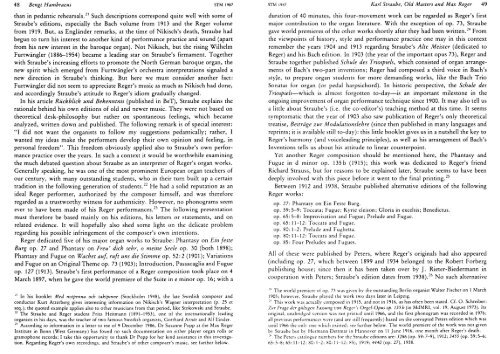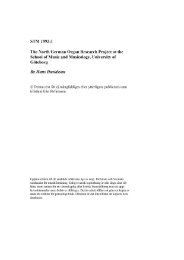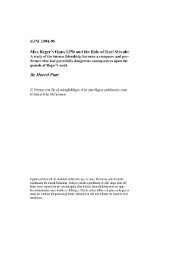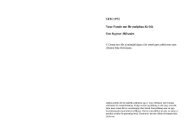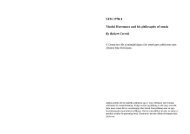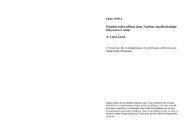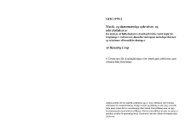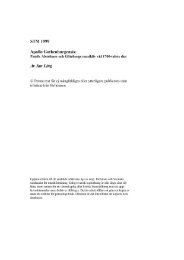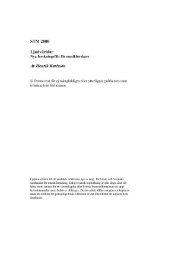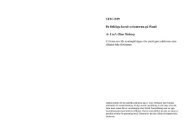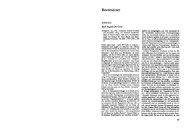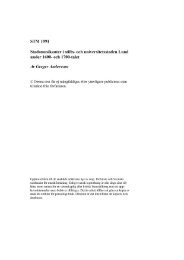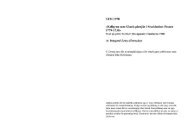Create successful ePaper yourself
Turn your PDF publications into a flip-book with our unique Google optimized e-Paper software.
than in pedantic rehearsals. 21 Such descriptions correspond quite well with some of<br />
Straube’s editions, especially the Bach volume from 1913 and the Reger volume<br />
from 1919. But, as Engländer remarks, at the time of Nikisch’s death, Straube had<br />
begun to turn his interest to another kind of performance practice and sound (apart<br />
from his new interest in the baroque organ). Not Nikisch, but the rising Wilhelm<br />
Furtwängler (1 886-1954) became a leading star on Straube’s firmament. Together<br />
with Straube’s increasing efforts to promote the North German baroque organ, the<br />
new spirit which emerged from Furtwängler’s orchestra interpretations signaled a<br />
new direction in Straube’s thinking. But here we must consider another fact:<br />
Furtwängler did not seem to appreciate Reger’s music as much as Nikisch had done,<br />
and accordingly Strau be’s attitude to Reger’s idiom gradually changed.<br />
In his article Rückblick und Bekenntnis (published in BeT), Straube explains the<br />
rationale behind his own editions of old and newer music. They were not based on<br />
theoretical desk-philosophy but rather on spontaneous feelings, which became<br />
analyzed, written down and published. The following remark is of special interest:<br />
“I did not want the organists to follow my suggestions pedantically; rather, I<br />
wanted my ideas make the performers develop their own opinion and feeling, in<br />
personal freedom”. This freedom obviously applied also to Straube’s own perfor-<br />
mance practice over the years. In such a context it would be worthwhile examining<br />
the much debated question about Straube as an interpreter of Reger’s organ works.<br />
Generally speaking, he was one of the most prominent European organ teachers of<br />
our century, with many outstanding students, who in their turn built up a certain<br />
tradition in the following generation of students.22 He had a solid reputation as an<br />
ideal Reger performer, authorized by the composer himself, and was therefore<br />
regarded as a trustworthy witness for authenticity. However, no phonograms seem<br />
ever to have been made of his Reger performances.23 The following presentation<br />
must therefore be based mainly on his editions, his letters or statements, and on<br />
related evidence. It will hopefully also shed some light on the delicate problem<br />
regarding his possible infringement of the composer’s own intentions.<br />
Reger dedicated five of his major organ works to Straube: Phantasy on Ein feste<br />
Burg op. 27 and Phantasy on Freu’ dich sehr, o meine Seele op. 30 (both 1898);<br />
Phantasy and Fugue on Wachet auf ruft uns die Stimme op. 52: 2 (1901); Variations<br />
and Fugue on an Original Theme op. 73 (1903); Introduction, Passacaglia and Fugue<br />
op. 127 (1913). Straube’s first performance of a Reger composition took place on 4<br />
March 1897, when he gave the world premiere of the Suite in e minor op. 16; with a<br />
21 In his booklet Med notpenna och taktpinne (Stockholm 1948), the late Swedish composer and<br />
conductor Kurt Atterberg gives interesting information on Nikisch’s Wagner interpretation (p. 25 et<br />
seq.); the quoted example applies also to other musicians from that period, like Stokowski and Straube.<br />
22 The Straube and Reger student Fritz Heitmann (1891-1953), one of the internationally leading<br />
organists in his days, was the teacher of two famous Swedish organists, Gotthard Arnér and Alf Linder.<br />
23 According to information in a letter to me of 9 December 1986, Dr Susanne Popp at the Max Reger<br />
Institute in Bonn (West Germany) has found no such documentation on either player organ rolls or<br />
gramophone records; I take this opportunity to thank Dr Popp for her kind assistance in this investiga-<br />
tion. Regarding Reger’s own recordings, and Straube’s of other composer’s music, see further below.<br />
duration of 40 minutes, this four-movement work can be regarded as Reger’s first<br />
major contribution to the organ literature. With the exception of op. 73, Straube<br />
gave world premieres of the other works shortly after they had been written.24 From<br />
the viewpoints of history, style and performance practice one may in this context<br />
remember the years 1904 and 1913 regarding Straube’s Alte Meister (dedicated to<br />
Reger) and his Bach edition. In 1903 (the year of the important opus 73), Reger and<br />
Straube together published Schule des Trospiels, which consisted of organ arrange-<br />
ments of Bach’s two-part inventions; Reger had composed a third voice in Bach’s<br />
style, to prepare organ students for more demanding works, like the Bach Trio<br />
Sonatas tor organ (or pedal harpsichord). In historic perspective, the Schule des<br />
Triospiels— which is almost forgotten to-day— is an important milestone in the<br />
ongoing improvement of organ performance technique since 1900. It may also tell us<br />
a little about Straube’s (i.e. the co-editor’s) teaching method at this time. It seems<br />
symptomatic that the year of 1903 also saw publication of Reger’s only theoretical<br />
treatise, Beiträge zur Modulationslehre (since then published in many languages and<br />
reprints; it is available still to-day): this little booklet gives us in a nutshell the key to<br />
Reger’s harmony (and voiceleading principles), as well as his arrangement of Bach’s<br />
Inventions tells us about his attitude to linear counterpoint.<br />
Yet another Reger composition should be mentioned here, the Phantasy and<br />
Fugue in d minor op. 135 b (1915); this work was dedicated to Reger’s friend<br />
Richard Strauss, but for reasons to be explained later, Straube seems to have been<br />
deeply involved with this piece before it went to the final printing.25<br />
Between 1912 and 1938, Straube published alternative editions of the following<br />
Reger works:<br />
op. 27: Phantasy on Ein Feste Burg.<br />
op. 59: 5-9: Toccata; Fugue; Kyrie eleison; Gloria in excelsis; Benedictus.<br />
op. 65 : 5-8 : Improvisation and Fugue; Prelude and Fugue.<br />
op. 65: 11-12: Toccata and Fugue.<br />
op. 80: 1-2: Prelude and Fughetta.<br />
op. 80: 11-12: Toccata and Fugue.<br />
op. 85: Four Preludes and Fugues.<br />
All of these were published by Peters, where Reger’s originals had also appeared<br />
(including op. 27, which between 1899 and 1934 belonged to the Robert Forberg<br />
publishing house; since then it has been taken over by J. Rieter-Biedermann in<br />
cooperation with Peters; Straube’s edition dates from 1938).26 No such alternative<br />
24 The world premiere of op. 73 was given by the outstanding Berlin organist Walter Fischer on 1 March<br />
1905; however, Straube played the work two days later in Leipzig.<br />
25 This work was actually composed in 1915, and not in 1916, as has often been stated. Cf. O. Schreiber:<br />
Zur Frage der gültigen Fassung von Reger’s Orgel-Opus op. 135 b (in MdMRI, vol. 19, August 1973). Its<br />
original, unabridged version was not printed until 1966, and the first phonogram was recorded in 1976;<br />
all previous performances were (and are still frequently) based on the corrupted Peters edition which was<br />
until 1966 the only one which esisted; see further below. The world premiere of the work was not given<br />
by Straube but by Hermann Dettmar in Hannover on ii June 1916, one month after Reger’s death.<br />
26 The Peters catalogue numbers for the Straube editions are: 3286 (op. 59: 7-9), 1912; 3455 (op. 59: 5-6;<br />
65:5-8; 65: 11-12: 80: 1-2; 80: 11-12: 85), 1919; 4440 (OP. 27), 1938.


